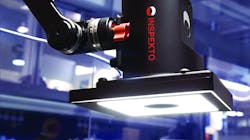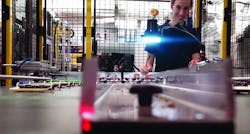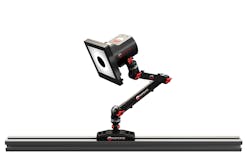One of the key methods used for quality assurance processes is visual inspection. It can be done the good old-fashioned way by human inspectors, or in some cases by developing a machine vision solution for the challenge at hand. For example, during the final packaging stages, visual inspection may check barcodes, ensure products are correctly labeled and aid traceability throughout the process. This enables manufacturers to be confident in the ability of their processes, the quality of their product and the satisfaction of their customers.
Increasing pressures from consumers, the competitive industry and a growing body of regulation compels manufacturers to increase their focus on product quality. One option for them is to use human manual inspectors. However, the downside of this is a high rate of error — around 25% or higher. This is because manual visual inspection is a hugely challenging task, requiring employees to keep their focus across eight-hour shifts, looking at the very same product thousands of times.
Another downside is that good people are taken away from production and instead paid for performing a task that calls for machine intervention. To add insult to injury, unhappy customers will frequently file claims and complaints, hurting manufacturer’s pockets, reputations and profitability.
The Inspekto S70, the world’s first autonomous machine vision system
Enter machine vision
The present category of machine vision solutions was introduced to market some three decades ago, and indeed, visual inspection is a quicker and more painless task for a machine to perform than for a human being. It also comes with a big bonus: allowing manufacturers to redirect their human workforce into far more valuable roles, as well as save on labor costs — a double advantage. Altogether, machine vision-based quality assurance, even at its current state, is an important component in improving process productivity, yield and profit.
Since their debut, machine vision solutions have consistently grown in popularity and according to Markets Insider, the overall industrial machine vision sector is expected to grow to $12.29 billion by 2023, at a compound annual growth rate of 7.61%. However, this growth is hindered by a number of factors.
Inspekto S70 installation at Mahle
What’s the problem?
Unfortunately, manufacturers have been held back from reaping the envisioned benefits of machine vision by the inherent limitations of the technologies underlying current solutions. One major barrier is that machine vision solutions are notoriously complex. So much so, that once a quality assurance challenge is defined, manufacturers simply cannot implement one themselves and must arrange for a vision systems integrator to fulfill the entire project.
The vision systems integrator must then exploit the manufacturer’s employees to generate a myriad of images of the inspected product, help annotate them, simulate and annotate defective products and then design, develop, program and eventually implement their hard-engineered machine vision solution onto the production line. The process involves selecting numerous components from cameras and lighting devices to lenses and software to hardware interfaces and complex structures. It requires time and manpower-consuming processes and intensive application of machine vision expertise, artificial intelligence knowledge, hardware engineering skills and accurate setup proficiencies.
The manufacturer foots the bill for the services of the vision integrator, pays for a vast array of components and loses out on productivity during production downtime. While the army of experts develops the machine vision solution, the manufacturer has no choice but to employ human inspectors, be pushed to random checks, or even worse, halt production altogether.
Such downtime periods usually last between many weeks to many months, depending on the complexity of the machine vision solution at hand. The costs of the entire project are seldom lower than $50,000, and will frequently spiral to more than $100,000, when there’s no guarantee that the solution would eventually be successful. Many manufacturers simply cannot afford to lose these amounts, nor take such risks on their lines. The combination of long wait times and painfully high costs are significant barriers to implementing machine vision technology.
Once implemented, a traditional machine vision solution is fixed to a specific location and can only inspect one particular product. If any changes are made, for example, if a label is redesigned or another feature is added to a package, the manufacturer will have to request the services of the integrator all over again, to adjust the solution at an additional expense. If amending the solution is not possible, the manufacturer is left with no choice but to start from scratch and commission an entirely new machine vision solution, vastly adding to project costs. At the end of this process, the manufacturer has just one machine vision solution, serving one single inspection task, at one single location on one single manufacturing line.
In other cases, it may be impossible for the systems integrator to develop a solution for the application at all. If the manufacturer is producing multiple products on the same line, for example, with injection molding, the inflexible traditional solutions would be unable to cope with the requirements of a multiproduct application.
In other processes, such as metal casting or aluminium processing, a machine vision solution is often unable to cope, due to the low contrast caused by the material’s grey coloring. In addition, contemporary machine vision solutions find it hard, or completely impossible, to address the natural variations in alloys, and the infinite variations of surfaces. On top of that, it is difficult to train solutions on what constitutes a defect and what constitutes a good part. The process of training a solution by showing it hundreds or thousands of good and defective parts can still result in inaccurate results in such applications. In these circumstances, instead of benefitting from machine vision, the manufacturer would be stuck using manual inspection, an expensive and inaccurate approach.
The drawbacks of traditional machine vision solutions — primarily the cost, long wait times, complexity and inflexibility — make it difficult for manufacturers to implement machine vision solutions at every required point on the line. The most common approach is to install such technology for a final, end-of-line check. This means manufacturers are not identifying flaws until it is too late and they are unable to improve their own processes.
The Inspekto S70, the world’s first autonomous machine vision system. All images courtesy of Inspekto
The future is here
Technology is now available to remove the barriers and enable industrial plants to reap the huge benefits of machine vision quality assurance. The introduction of the first autonomous machine vision (AMV) market entries in late 2018, means that manufacturers can now opt for systems that are quick and easy to install, require no downtime and can be installed by the plant’s own personnel — all for a modest price tag.
Such AMV systems use an array of artificial intelligence engines working in tandem to optimize and self-set the system. They are installed on the manufacturing line, requiring no vision or artificial intelligence knowhow and requiring no tools, only a computer mouse. AMV systems introduce the flexibility that traditional solutions lack, meaning that they can inspect products in varying environmental conditions and adapt to perform any new function they are put to. One particular breakthrough is that AMV systems are able to inspect any number of different products at the same location on the line, something that has never before been possible.
Inside insight — Total QA
AMV systems are integrator-less and affordable, which means that manufacturers can benefit from total quality assurance (QA) — visual QA at every required stage of production. Total QA means that manufacturers can identify defects as soon as they occur and instantly remove them from the line, leading to reduced scrap and boosted yield and productivity.
The system that keeps on giving — sharp apps applied to the line
An AMV system installed even on one location on the line will quickly improve line productivity in a growing variety of aspects. A rich variety of software modules ("apps") can be installed to each AMV system on the line — serving the particular needs of the manufacturer on that particular production location. The first application can be the visual quality assurance app already bringing huge impact to the line as explained.
But that would only be the beginning. Each app installed will yield more and more value, pushing productivity higher and higher. For example, an archiving and traceability app will immediately see to archive all products’ visual data and metadata — as soon as these products are viewed by the AMV system. The traceability app will then allow easy access to that data, for example, to address or reject an unjustified claim by a customer; or to optimize production, by tracking down the exact location and time where a defect was introduced, so that the manufacturer can address the malfunction.
Another app that can be installed on an AMV system can turn it into "many systems in one." This means that the AMV system can be set, in minutes, to inspect any number of products on that same location on the production line. For instance, a system running on a plastic injection machine can be set to inspect all the products that are made by the various plastic injection modules used on that machine.
The breakthrough of AMV here is, that by installing one software app on an already installed system, the manufacturer saves the costs, time and headache of implementing, say, 40 or 50 old-world machine vision solutions on that location.
By adding additional apps to an AMV system on the line, manufacturers can improve productivity in leaps and bounds. All of this can be achieved autonomously, with no external vision systems integrator required, giving the manufacturer total independence.
Installing many AMV systems across the manufacturing plant enables total QA, which means that an incorrectly labeled package will never again be damaging to the supply chain. During all steps of production, the manufacturer can be sure that all equipment is working correctly and if it is not, rapidly take action to prevent the mistake from reoccurring.
Autonomous machine vision improves production lines’ productivity in ways previously unimaginable. Systems that are immediate, affordable and integrator-less help manufacturers to ensure that their products are in line with specification and reduce waste by preventing good components from being combined with defective ones. It probably isn’t surprising that when true independence is given to process managers, their lines’ productivity is put on a path pointing in one direction. Upward.
Harel Boren is a veteran hands-on performer of the Israeli high-tech community. Prior to co-founding Inspekto, Boren held key executive roles in tech startups and corporations, including two major technology exits (NASDAQ, M&A), yielding together more than $1 billion in returns. A mentor to tens of technology startups, Boren is among the first to lead the way of Israeli tech to the European industrial and investment communities. Boren holds a Bachelor of Science in economics and an LLB from the Tel Aviv University.
Zohar Kantor spent nearly 20 years in growing the business of Israeli tech startups and managing global accounts at major hardware and software vendors Flash Networks and Comverse. He has an LLB from the University of East London and an MBA from Middlesex University. He speaks fluent English, Italian and Hebrew.







